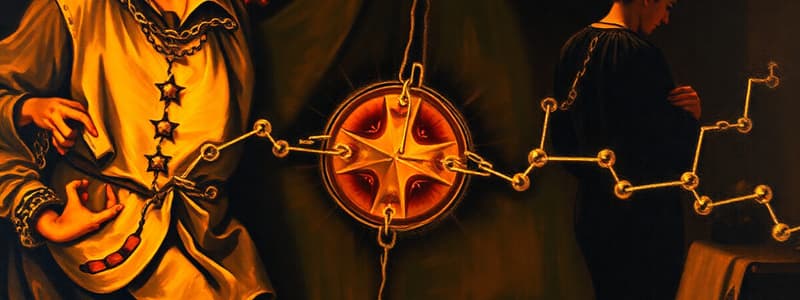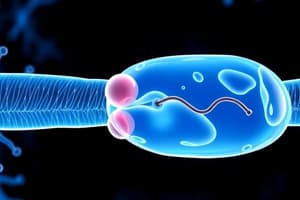Podcast
Questions and Answers
In the pyruvate dehydrogenase complex, what role does thiamine pyrophosphate (TPP) play?
In the pyruvate dehydrogenase complex, what role does thiamine pyrophosphate (TPP) play?
- Picking up two electrons and reducing $NAD^+$ into NADH + $H^+$ .
- Restoring the oxidized form of lipoamide.
- Accepting and carrying the acetyl group formed from pyruvate.
- Catalyzing the initial decarboxylation and oxidation-reduction steps of pyruvate. (correct)
What is the primary mechanism by which the pyruvate dehydrogenase complex (PDC) is regulated?
What is the primary mechanism by which the pyruvate dehydrogenase complex (PDC) is regulated?
- Direct activation by insulin signaling.
- Allosteric regulation by substrate availability alone.
- Transcriptional control based on cellular energy demands.
- Feedback regulation through covalent modification. (correct)
During the citric acid cycle, which enzyme facilitates both dehydration and rehydration steps using an iron-sulfur cluster?
During the citric acid cycle, which enzyme facilitates both dehydration and rehydration steps using an iron-sulfur cluster?
- Aconitase (correct)
- Citrate Synthase
- Malate Dehydrogenase
- Isocitrate Dehydrogenase
If the electron transport chain is backed up due to oxygen deficiency, what immediate effect would this have on the levels of $QH_2$?
If the electron transport chain is backed up due to oxygen deficiency, what immediate effect would this have on the levels of $QH_2$?
Which of the following best describes the role of the glyoxylate cycle in plants?
Which of the following best describes the role of the glyoxylate cycle in plants?
What would be the outcome of a deficiency in the E3 subunit of the pyruvate dehydrogenase complex?
What would be the outcome of a deficiency in the E3 subunit of the pyruvate dehydrogenase complex?
Why is increasing thiamine (Vitamin B1) intake a potential treatment strategy for patients with a mutation affecting the E1 subunit of pyruvate dehydrogenase (PDH)?
Why is increasing thiamine (Vitamin B1) intake a potential treatment strategy for patients with a mutation affecting the E1 subunit of pyruvate dehydrogenase (PDH)?
How does cyanide poisoning disrupt cellular respiration and ATP production?
How does cyanide poisoning disrupt cellular respiration and ATP production?
Substrates of the Krebs cycle may become inhibited by NADH. Which of the following is such a substrate?
Substrates of the Krebs cycle may become inhibited by NADH. Which of the following is such a substrate?
In the Q cycle, which component passes its electron to cytochrome c?
In the Q cycle, which component passes its electron to cytochrome c?
What is the primary purpose of the symport mechanism in the context of pyruvate metabolism?
What is the primary purpose of the symport mechanism in the context of pyruvate metabolism?
During regulation of the pyruvate dehydrogenase complex (PDC), what effect does a high ATP/ADP ratio have?
During regulation of the pyruvate dehydrogenase complex (PDC), what effect does a high ATP/ADP ratio have?
Within the citric acid cycle, what is the role of succinate dehydrogenase?
Within the citric acid cycle, what is the role of succinate dehydrogenase?
If the malate-aspartate shuttle is inhibited, what would be the immediate consequence on NADH transport?
If the malate-aspartate shuttle is inhibited, what would be the immediate consequence on NADH transport?
What is a key difference between mitochondrial and cytoplasmic aconitase?
What is a key difference between mitochondrial and cytoplasmic aconitase?
In the electron transport chain, what role does coenzyme Q (CoQ) play?
In the electron transport chain, what role does coenzyme Q (CoQ) play?
How does the action of the glyoxylate cycle contribute to plant metabolism?
How does the action of the glyoxylate cycle contribute to plant metabolism?
Considering the regulation of the citric acid cycle, what is the effect of a high NADH/NAD+ ratio on enzymes such as isocitrate dehydrogenase and α-ketoglutarate dehydrogenase?
Considering the regulation of the citric acid cycle, what is the effect of a high NADH/NAD+ ratio on enzymes such as isocitrate dehydrogenase and α-ketoglutarate dehydrogenase?
Why is oxygen deprivation detrimental to the electron transport chain?
Why is oxygen deprivation detrimental to the electron transport chain?
What is the direct role of thiamine pyrophosphate (TPP) in the pyruvate dehydrogenase complex (PDC)?
What is the direct role of thiamine pyrophosphate (TPP) in the pyruvate dehydrogenase complex (PDC)?
Flashcards
Pyruvate Decarboxylation
Pyruvate Decarboxylation
Process where pyruvate, formed from glycolysis, travels to the mitochondrion.
Pyruvate Dehydrogenase Complex
Pyruvate Dehydrogenase Complex
A protein complex that catalyzes pyruvate decarboxylation.
TPP
TPP
Thiamine pyrophosphate; prosthetic group attached to E1.
Pyruvate Dehydrogenase
Pyruvate Dehydrogenase
Signup and view all the flashcards
Feedback Regulation
Feedback Regulation
Signup and view all the flashcards
Electron Transport Chain
Electron Transport Chain
Signup and view all the flashcards
Cytochrome C
Cytochrome C
Signup and view all the flashcards
Coenzyme Q
Coenzyme Q
Signup and view all the flashcards
Citrate Synthase
Citrate Synthase
Signup and view all the flashcards
α-ketoglutarate dehydrogenase
α-ketoglutarate dehydrogenase
Signup and view all the flashcards
Pyruvate entry to mitochondria
Pyruvate entry to mitochondria
Signup and view all the flashcards
Pyruvate dehydrogenase function
Pyruvate dehydrogenase function
Signup and view all the flashcards
Dihydrolipoyl transacetylase (E2)
Dihydrolipoyl transacetylase (E2)
Signup and view all the flashcards
Dihydrolipoyl dehydrogenase (E3)
Dihydrolipoyl dehydrogenase (E3)
Signup and view all the flashcards
Lipoic Acid Function
Lipoic Acid Function
Signup and view all the flashcards
Complex II
Complex II
Signup and view all the flashcards
Cyanide Poisoning
Cyanide Poisoning
Signup and view all the flashcards
Malate dehydrogenase
Malate dehydrogenase
Signup and view all the flashcards
Fumerase function
Fumerase function
Signup and view all the flashcards
Study Notes
Pyruvate Decarboxylation
- Pyruvate forms from glycolysis, travels to the mitochondrion, and undergoes pyruvate decarboxylation.
- For pyruvate to enter the mitochondrial matrix, it must bring an H+ and enter via a symport mechanism because it is very polar and requires H+.
- The membrane is permeable, but it is difficult for pyruvate to actually enter the matrix.
- The entire process is catalyzed by the protein complex pyruvate dehydrogenase complex.
Pyruvate Dehydrogenase Complex
- Composed of 60 subunits, 3 functional enzymes, and utilizes 5 different cofactors
- E1 (pyruvate dehydrogenase) catalyzes the first two steps, which are decarboxylation and oxidation-reduction.
- E2 (dihydrolipoyl transacetylase) transfers the acetyl group formed in steps 1 and 2 onto CoA.
- E3 (dihydrolipoyl dehydrogenase) restores the oxidized form of lipoamide.
Coenzymes utilized
- Thiamine pyrophosphate (TPP) is a prosthetic group attached to E1.
- Lipoic acid is utilized.
- CoA is used to carry the acetyl group, which is a 2-carbon component removed from pyruvate.
- FAD picks up 2 electrons and reduces NAD+ into NADH + H+.
- NAD+ gets reduced by FAD.
Key Steps
- Step 1: Decarboxylation is heavily exergonic, powering the following steps.
- Step 2: Oxidation-reduction is catalyzed by pyruvate dehydrogenase, transferring the acetyl group to lipoamide, reducing it, and oxidizing TPP.
- Step 3: The acetyl group is transferred from acetyllipoamide to CoA via dihydrolipoyl transferase (E2)
- Step 4: Regeneration of lipoamide occurs via dihydrolipoyl dehydrogenase (E3), passing electrons to FAD.
Regulation of Pyruvate Decarboxylation
- Feedback regulation is facilitated by covalent modification (Pi).
- Acetyl-CoA and NADH + H+ regulate E2 and E3, respectively, by phosphorylating a protein kinase, which phosphorylates E1 and E2, making them inactive.
- Ca2+ and Mg2+ promote pyruvate decarboxylation by inactivating protein kinase and activating phosphatases, which remove phosphate from the pyruvate dehydrogenase complex, allowing it to proceed.
- High energy charge of the cell (high ATP, low ADP) inhibits pyruvate decarboxylation by phosphorylating the complex.
- A low energy charge of the cell (low ATP; high ADP) will dephosphorylate the complex.
- If citrate is high, the TCA cycle functions and the system does not need to be overwhelmed with incoming Acetyl CoA.
- If NADH is high, it either means that ATP production isn't necessary, or the ETC is backed up by O2 malfunction or deficiency (oxygen deprivation).
The Citric Acid Cycle (TCA)
- It is an amphibolic pathway (catabolic and anabolic, depending on pathway taken)
- cellular respiration cycles yield 2 NADH + 2 ATP in glycolysis, 2 NADH in transition, 6 NADH, 2 FADH, and 2 GTP in the Kreb's cycle
- In total, it contains 38 ATP (40% effective).
Side Pathways Include
- Phosphoenolpyruvate carboxykinase
- Pyruvate Carboxylase
- Fatty Acids
Malate Dehydrogenase
- Reversible reaction, oxidizes Malate into oxaloacetate.
Fumerase
- Preforms a hydration reaction with a Carbanion intermediate and is a reversible reaction.
Citrate Synthase
- Condenses oxaloacetate and Acetyl-CoA.
- Irreversible enzyme.
- Not regulated by anything other than concentration.
- High citrate inhibits PFK1 of glycolysis because it indicates an adequate glycolysis process.
Aconitase
- Facilitates dehydration/rehydration steps by utilizing [4Fe-4S] cluster and forms Cis Intermediate.
- Cytoplasmic aconitase regulate iron production, and can reversibly form Iron-sulfur clusters states.
Isocitrate Dehydrogenase
- Oxidizes Isocitrate
Succinate Dehydrogenase
- Catalyzes dehydration utilizing FAD as a cofactor.
- The reduction potential of FAD favors C-C to C=C bond formation
Succinyl-CoA Synthase
- Also referred to as the misleading name, succinyl-phosphate intermediate forms hydrolyzing thioester bonds off and harvesting enough energy to add a phosphate group.
- CoA is released here.
- Enzyme-histidine takes the phosphate group back off, then uses it to perform substrate-level phosphorylation of GDP.
Anapleurotic Reactions
- Can "back fill" Kreb's Cycle at Intermediates
- Fatty acid breakdown can only form Acetyl CoA, so the condensation reaction that allows the cycle to continue requires a 1:1 ratio of Acetyl CoA to oxaloacetate
- Oxaloacetate can produce more glucose, which can create sugars into Fats but cannot make sugars
- Plants are capable of this.
- Seeds store plant energy in an macylglycerides, therefore they generally store a higher percentage of fats rather than sugar for long term storage.
Glycoxylate Modifications
- Glycoxylate cycle will bypass oxidative decarboxylations, thereby retaining 2 carbons that are generally lost as Co2.
- Enables the carbons to recycle efficiently.
- This process allows plants to convert fatty acids into sugars.
Oxidative Phosphorylation and the Electron Transport Chain
- The membranes selectivity drives the electron transport chain.
Malate-Aspartate Shuttle
- Birds can bypass this shuttle and lose some energy in the process or roughly 2 ATP.
- Overview of oxidoreductase reactions and electrochemistry of the electron transport chain
- Oxidation occurs at the Anode, Reduction occurs at the cathode
- If Standard EMF valve is positive, it likes to be reduced and vise versa.
- NADH has Ecell equaling -0.32 v, meaning it likes to get oxidized, but Oxygen has E°cell of + 0.82v meaning it likes to get reduced.
- Standard Free Energy is −220 kJ/mol
- 02 -> H20 is the ideal "reduction-potential" to yield electrons
Electrons Transportation Details
- Complex II Succinate Dehydrogenase FAD
- Succinare to Fumerate results in 2 ATP's instead of
- Cyanide Poisioning inhibits Complex II, killing cells.
- Fmn can exist in reduced, oxidized or semiquinone format, however Because NADH is the ideal election donor, it only fluctuates in mammals.
- Coenzyme Q can exist as CoQ (oxidized), QH (semiquinone/radicalized) or QH2 (Fully reduced).
- Cytochrome C can only accept 1 electron at a time
- Cytochrome C an major initiator of apoptosis
- Contains iron-sulfer cluster called "Rieske Center"
Q-Cycle
- NADH OR FAD will lose all electrons at the eventual reduction into QHz form
- the 2 required QHz will get regenerated and also reduced.
- QH₂ binds to the Qo site, le is passed to the iron-sulfer cluster (pumps 2 H+ out)
- the radicalized QH then pass the election to heme b₂, leaving an oxidized CoA and allowing the NADH cycle to continue.
Class Practice Problems
- Deficiency of Pyruvate dehydrogenase and a severe E3 Subunit mutation would result in Pyruvate increase, leading to severe lactic acid build up (lactic acidosis).
- In effort to treat a patient with E1 of PDH, increase Vitamin B, thiamine, intake.
Jogging Effects
- When starting to jog and becoming short of breath the Following can be observed.
- NADH increases because Oz not readily available in ETC.
- ATP decreases blc Its being used for muscle contraction.
- α-ketogluterate decreases due to Innibition by increased amounts of NADH
- key substrates of the kreb's cycle inhibited by NADH are lsocitrate dehydrogenase and α-ketogluterate dehydrogenase.
- 1 NADH theoretically should be able to yield 7 ATP.
- the enzyme of krebs cycle that produces nucleoside triphosphate is Succinyl CoA Synthase.
- pyruvate decarboxylation reaction occurs in mitochondrial Intermembrane Space
- Once Pyruvate forms from glycolysis, It travels to the mitochondrion.
- Pyruvate must bring a H+ and enter via a symport mechanism because it is polar and requires H+.
- The membrane is permeable, but difficult to enter the matrix.
- The entire process is catalyzed by a protein complex.
- Pyruvate dehydrogenase complex is made up of 60 subunits, 3 function enzymes, and utlizies 5 cofactors.
- Pyruvate dehydrogenase catalyzes the first two states (decarbox;oxidation-reduction)
- Dihydrolipoyl transacetylase transfers acetal gorup fomed onto CoA
- Dihydrolipoyl dehydrogenase restores oxidized form of lipoamide
- Coenzymes utilized include, Thiamine Pyrophosphate (Tpp) with a prosthetic group attached to El, Lipoic Acid ,COA which is used to cartt the acetyl group, Fad picks yo 2 electrons, Nad gets reduced by Fat
Steps To Creating Energy
- 1 Decarboxylation is heavily exergonoic for powering steps
- 2 Oxidation- reduction
- 3.Acetly group transeferred from acetyllipoamide to CoA
- 4 lipoamide Regenerated
Regulation of Pyruvate Decarboxylation
- Feedback regulation is facilitated by covalent modification
- Acetyl-coA and NAHD determine enzymes
- Magnesium and calcium both promote pyruvate decarboxylation.
- High energy inhibits decarboxylation and vice versa.
Citric Acid Cycle
- Amplipathic pathway depending on path taken
- Side pathways include several enzymes
- Malate Dehydrogenase oxidizes material
- Fumerase prefroms a Hydration reaction
- Citrate synthase combines elements
- Acotinase facilitates dehydration
Succinate Details
- Succinate dehydration favors C-C bonds
- Succinyl- COA uses a histadine to promote function
- Can backfill at intermediates
- Glycolosate cycles work to improve glucose yields
Electron Chains and Transport
- Membrane selectivity drives this
- Bypass option for birds yields less atp
- Electrohemistry is red cat ox system
- Electon potentials are 1/1 on reduction and oxidation forms
- 02-120 is large harvesting product
- Cyanide inhibits cycle
- 7theoretical atp for each nadh
- Cytocrome has heme grps and cytocrome C initiates apoptosis
- Nad and ofad are recued into different forms
- Coh2 binds, allows 2H to go on cycle
Studying That Suits You
Use AI to generate personalized quizzes and flashcards to suit your learning preferences.




